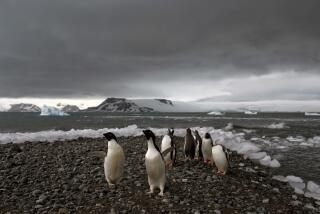Volcanic heat helped Antarctic life survive the ice age
- Share via
If an ice age is coming and you are a lichen in Antarctica, you better hope you live near a volcano.
A new study suggests organisms native to the South Pole survived ice ages by huddling in pockets of warmth created by the heat of underground volcanoes.
“These slightly warmer areas would have kept some parts of the continent ice free and let organisms survive on that land,” said Peter Convey of the British Antarctic Survey. “Then, when the ice receded, the plants and animals spread out from that refuge to occupy other places.”
(To see what these hot spots look like today, click on the photo gallery above.)
Even at its most hospitable, Antarctica is a difficult place for terrestrial organisms to live, with scant patches of dry land. But during the Earth’s periodic ice ages, it becomes all but uninhabitable as nearly all of the ice-free land disappears.
For decades, many scientists thought it was impossible for the lichens, moss, primitive insects and round worms that live in the Antarctic to survive an ice age. Instead, they proposed that the plants and animals living there now must be relatively recent colonizers - arriving since the last ice age receded about 20,000 years ago.
But further study revealed that can’t be the case. A third to a half of the living organisms in the Antarctic are found there and only there. Since it would have taken these organisms millions of years to evolve to their present forms, they had to have been living on the icy continent through several ice ages. The question is how.
Enter the “geothermia glacial refugia” hypothesis that suggests plants and animals native to the Antarctic survived ice ages only when they were lucky enough to live near places warmed by geothermal heat.
To test this theory, the researchers turned to the largest record of Antarctic fauna and flora available and found that the highest diversity of animals and plants were indeed found around known volcanoes that either are active, or have been active, since the last great ice age.
The results of the study were published this week in the journal Proceedings of the National Academy of Sciences.
“When you look back at it, you think, ‘That was obvious,’ but this is a new finding for the Antarctic,” said Convey, one of the authors of the paper. “It is opening up a new way of thinking.”
The study, led by Ceridwen Fraser from the Australian National University and Aleks Terauds from the Australian Antarctic Division, also has implications that extend beyond Antarctica.
“In the last ice age in the Northern Hemisphere, we think plants and animals moved south as the ice moved south, and then when the ice moved north they moved back with it,” Convey said. “But this study opens up the possibility that hidden in there are things that survived in high latitude, up in the Arctic, thanks to geothermal heat.”
Does the glow of scientific learning warm you from the inside? Follow me on Twitter for more like this.







